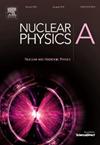在相对论框架下用等矢量标量δ介子连接中子蒙皮厚度和中子星观测值
IF 2.5
4区 物理与天体物理
Q2 PHYSICS, NUCLEAR
引用次数: 0
摘要
在48Ca (CREX)和208Pb (PREX-II)上的奇偶电子散射实验的最新进展为中子趋肤厚度提供了新的认识。这些发现揭示了核物质参数(nmp)的几种观点,如对称能(J)及其线性密度依赖性(L),它们与非对称致密物质的状态方程(EoS)直接相关。PREX结果导致L变硬,因此需要更硬的EoS,而CREX实验倾向于更软的L,因此更软的EoS。因此,在相对论平均场(RMF)模型中同时产生(48Ca和208Pb)的中子皮是一项挑战。为了解决这个问题,我们提出了基于RMF模型的相对论相互作用,该模型由自相互作用和σ, ω, ρ和δ介子的交叉相互作用组成。这些相互作用与两个实验的结果一致,它们准确地复制了与基态性质相关的实验数据,如闭合和开放壳层核的结合能(BE)和电荷半径(rch)。我们还计算了在β-平衡条件下由npeμ物质组成的相互作用的EoSs,从而计算了中子星的可观测值。本文章由计算机程序翻译,如有差异,请以英文原文为准。
Connecting neutron skin thickness and neutron star observables through isovector scalar delta meson in relativistic framework
Recent developments in the parity-violating electron scattering experiments on 48Ca (CREX) and for 208Pb (PREX-II) has provided new insight on the neutron skin thickness. These findings reveal several viewpoints on nuclear matter parameters (NMPs) such as symmetry energy (J) and its linear density dependency (L), which are directly related to the equation of state (EoS) of asymmetric dense matter. While PREX results lead to stiffer L and hence necessitate a stiffer EoS, the CREX experiments favor softer L and hence a softer EoS. Therefore, it is challenging to produce neutron skin of both (48Ca and 208Pb) in relativistic mean field (RMF) models simultaneously. To address this issue, we propose relativistic interactions based on RMF model comprising of self and cross interactions of σ, ω, ρ and δ mesons. These interactions are consistent with the results of both experiments, and they accurately replicate experimental data related to the ground state properties, such as binding energies (BE) and charge radii (), of both closed and open shell nuclei. We also compute the EoSs comprising of npeμ matter under β-equilibrium condition for the proposed interactions and hence calculate neutron star observables.
求助全文
通过发布文献求助,成功后即可免费获取论文全文。
去求助
来源期刊

Nuclear Physics A
物理-物理:核物理
CiteScore
3.60
自引率
7.10%
发文量
113
审稿时长
61 days
期刊介绍:
Nuclear Physics A focuses on the domain of nuclear and hadronic physics and includes the following subsections: Nuclear Structure and Dynamics; Intermediate and High Energy Heavy Ion Physics; Hadronic Physics; Electromagnetic and Weak Interactions; Nuclear Astrophysics. The emphasis is on original research papers. A number of carefully selected and reviewed conference proceedings are published as an integral part of the journal.
 求助内容:
求助内容: 应助结果提醒方式:
应助结果提醒方式:


